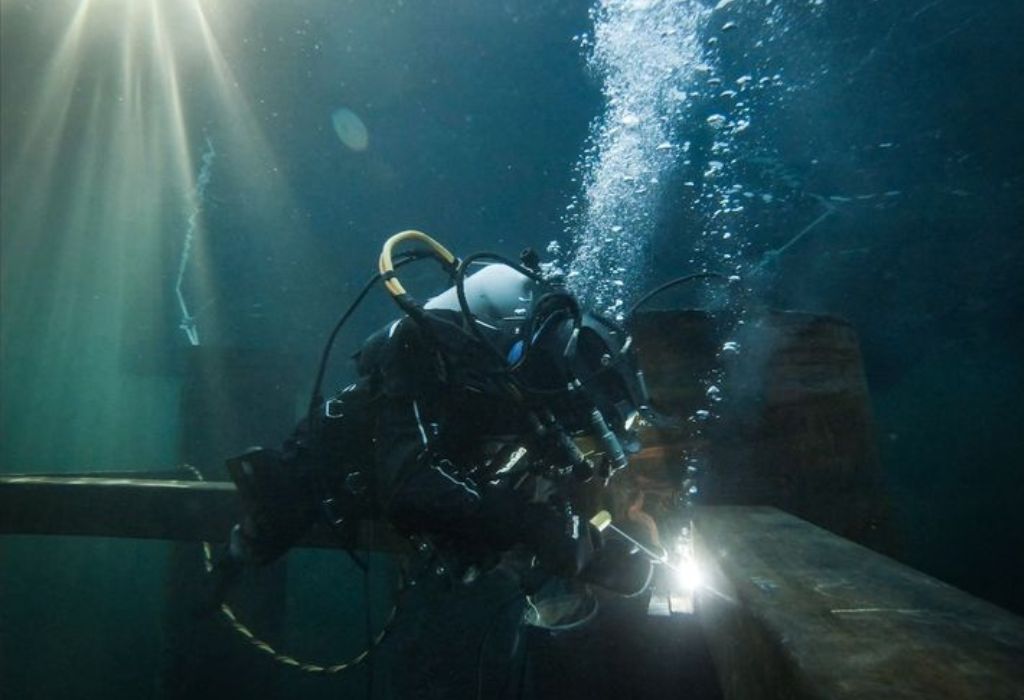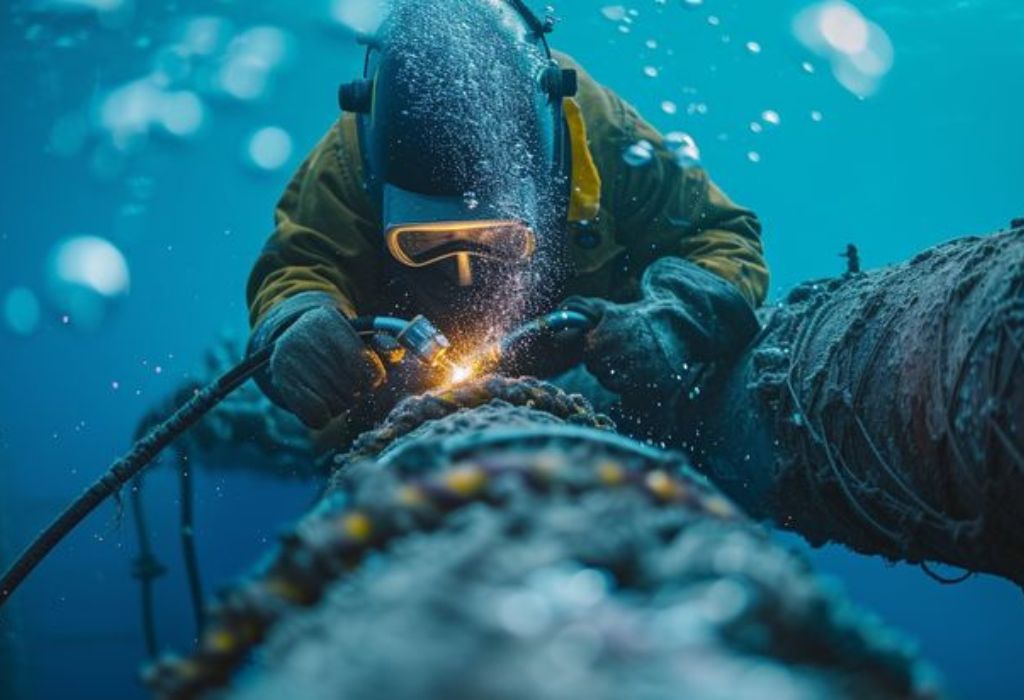The diver descends through dark water, guided only by a beam of light and the hum of electric current.
At depths where sunlight fades and pressure mounts, one mistake can be fatal.
Underwater welding has long been labeled one of the most dangerous jobs on earth.
Despite technological advances, the profession still faces risks that few people fully understand.
Each year, trained commercial divers enter the water to repair pipelines, ships, and oil rigs — yet some never resurface.
According to the U.S. Bureau of Labor Statistics, the fatal injury rate for commercial divers is 15 times higher than average (source).
Research from the Association of Diving Contractors International (ADCI) shows most deaths result from cascading failures — one small issue triggering another.
It might begin with a damaged cable, a gas pocket, or a missed decompression stop, but the end result is often the same.
What makes this profession so lethal isn’t just electricity or depth.It’s the perfect storm of pressure, gases, visibility, and human error working together.Even experienced divers are vulnerable when multiple hazards align.
This guide explores how people die from underwater welding, the science behind the risks, and the lessons learned that help prevent future tragedies.
What Underwater Welding Actually Involves

Underwater welding is not just striking an arc below the surface — it’s the intersection of diving, engineering, and physics.
Every weld happens in an environment that’s actively fighting the person performing it.
Most operations support offshore oil rigs, naval fleets, shipyards, and bridge repairs.
Two key techniques dominate: wet welding, performed directly in water, and dry hyperbaric welding, done inside pressurized chambers filled with gas.
Wet welding uses Shielded Metal Arc Welding (SMAW) with direct current to reduce electrical danger.
However, the diver still faces unstable visibility, water turbulence, and extreme pressure changes.
Dry welding offers greater control but requires heavy chambers and precise atmospheric regulation.
According to the International Marine Contractors Association (IMCA), underwater welders spend only 20 percent of their time actually welding, and the rest in cutting, rigging, and inspection (source).
This highlights how planning and safety dominate the job more than the welding itself.
Is underwater welding always done in the ocean?
No. It’s also done in harbors, lakes, dams, and water tanks where metal structures require repair.
Why is visibility so poor underwater?
Sediment, rust, and bubbles obscure vision, forcing divers to rely on tactile control and helmet lights.
What protective gear is essential?
Specialized diving suits, helmets, communication gear, and waterproof electrodes safeguard the worker.
Do welders work alone underwater?
Never. Each diver is connected to a surface team monitoring air, power, and line tension continuously.
How does the setup affect risk?
The closer the diver works to high-voltage equipment or compressed gas, the greater the potential for fatal error.
The Big Picture — How Do People Die from Underwater Welding?
Fatalities in underwater welding occur due to a combination of electrical shock, drowning, decompression sickness, gas explosions, and equipment failure.
Each cause has its own chain of contributing factors.
The average fatality rate for underwater welders has been estimated at 6–15 per 1000 workers, making it among the deadliest trades (source).
This number reflects both the complexity of the environment and the unforgiving nature of the work.
1. Electrical Shock
Water conducts electricity efficiently, and even a minor insulation fault can send lethal current through the diver.
Corroded cables, broken electrode holders, or damaged power leads are common culprits.
How does electric shock happen underwater?
When insulation fails, current seeks the shortest path to ground — often through the diver’s body.
What voltage is used for underwater welding?
Usually between 300 and 400 amps DC, which is enough to kill instantly if misdirected.
How can shock be prevented?
By using direct current (DC), sealed cables, and regular surface testing before dives.
Is electrocution the leading cause of death?
No, but it’s one of the top three recurring factors in underwater welding fatalities.
2. Drowning
When power loss or entanglement occurs, oxygen supply becomes the next critical threat.
A flooded mask, severed air hose, or malfunctioning regulator can lead to drowning within minutes.
Why is drowning so common underwater?
Because even brief panic or entanglement can prevent divers from surfacing before their air runs out.
How do welders prevent air loss?
Backup air tanks, umbilical lines, and surface standby divers serve as lifelines.
Can a diver drown in a dry chamber?
Yes. Chamber flooding or valve failure can quickly turn a sealed space into a death trap.
How fast does drowning occur?
A diver deprived of oxygen may lose consciousness in under 60 seconds, making rescue windows incredibly narrow.
3. Decompression Sickness (The Bends)
Decompression sickness (DCS) happens when dissolved gases, mainly nitrogen, form bubbles in the bloodstream during rapid ascent.
Underwater welders who skip or rush decompression stops risk stroke-like symptoms or paralysis.
What causes DCS?
Rapid pressure drop during ascent allows gas bubbles to expand in tissues and vessels.
How is it treated?
Immediate recompression in a hyperbaric chamber and pure oxygen therapy.
How many divers suffer DCS each year?
An estimated 1,000 U.S. divers annually experience some form of decompression illness (source).
Can DCS be fatal?
Yes. Severe cases can lead to embolism, cardiac arrest, or permanent neurological damage.
How is it prevented?
Strict adherence to decompression schedules and real-time depth monitoring.
4. Gas Explosions
Underwater welding generates gases like hydrogen and oxygen around the arc zone.
If these gases accumulate inside enclosed spaces, one spark can cause a powerful explosion.
Why are explosions so dangerous underwater?
Because confined water pressure amplifies shockwaves, causing lethal trauma even without direct burns.
Where do these explosions usually occur?
In ship hull cavities, pipelines, or sealed hyperbaric chambers.
How are gases controlled?
Continuous water circulation and ventilation systems dilute flammable gases.
Have such explosions caused multiple fatalities?
Yes. Historical records show entire teams killed due to trapped hydrogen in welding zones.
Can modern sensors prevent this?
Yes, gas-detection monitors are now standard on professional diving rigs.
5. Pressure and Barotrauma
Extreme underwater pressure compresses body cavities and equipment.
Even small miscalculations can rupture lungs or eardrums during ascent or descent.
What is barotrauma?
It’s physical damage caused by rapid pressure change, often affecting the lungs and sinuses.
How can welders avoid barotrauma?
By maintaining slow, steady ascent rates and equalizing pressure continuously.
What happens if the helmet pressure fails?
Sudden decompression can cause embolisms or eardrum rupture.
Do deep-sea welders face more risk?
Absolutely — the deeper the dive, the greater the strain on the body and equipment.
Can pressure injuries be permanent?
Yes, repeated trauma can lead to chronic ear or lung issues over time.
6. Equipment and Human Error
Most underwater welding deaths trace back to a combination of mechanical failure and human oversight.
Improper line handling, fatigue, and poor communication all amplify danger.
Why does fatigue matter?
Long hours underwater dull reaction time and increase the chance of error.
What kind of communication issues occur?
Faulty radio systems or misheard commands can delay emergency response.
Can training eliminate human error?
Not entirely, but ongoing certification and drills dramatically lower accident rates.
Who is responsible for maintenance?
Surface supervisors must inspect all cables, helmets, and tools before every dive.
Why do most accidents involve experienced divers?
Because familiarity sometimes breeds complacency — and one overlooked check can prove fatal.
Safety Standards and Prevention

Organizations such as OSHA, ADCI, and the U.S. Navy Diving Manual set strict safety protocols.
Following these reduces but doesn’t eliminate all risks.
Key safety measures include:
- Using low-voltage DC current
- Continuous communication with surface crew
- Pre-dive equipment inspection
- Strict decompression schedules
- Immediate access to hyperbaric chambers
According to OSHA’s marine division, over 70% of recent fatalities were linked to preventable causes, mostly poor supervision or equipment defects (source).
This shows how vital training and procedural discipline remain.
Do all underwater welders face the same risk?
No. Offshore and deep-sea jobs are far more hazardous than inland or shallow-water work.
Is there specialized insurance for this trade?
Yes. Most divers carry commercial diving insurance covering life, health, and decompression illness.
What role does technology play in safety?
Modern ROVs (Remotely Operated Vehicles) can perform some tasks, reducing diver exposure.
Are fatalities decreasing over time?
Slightly, thanks to improved training and awareness, but the occupation remains high-risk.
What is the average lifespan of an underwater welder?
Many transition to surface inspection or instructor roles after a decade to reduce exposure.
Conclusion
Underwater welding demands unmatched courage and precision.
Each dive is a race against physics, pressure, and time.
The truth behind how people die from underwater welding lies in a chain of small failures — from electricity to human fatigue.
Yet each tragedy pushes the industry toward safer equipment, stricter standards, and smarter preparation.
For anyone pursuing this career, knowledge and vigilance are the best armor.
Every weld beneath the waves tells a story of risk, resilience, and relentless commitment to building the world’s underwater foundations safely.

I’m Darrell Julian, the founder, lead writer, and hands-on welding enthusiast behind ArcWeldingPro.com. With more than 15 years of real-world welding experience, I created this platform to share what I’ve learned in the field, in the shop, and in the heat of the arc.


